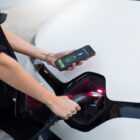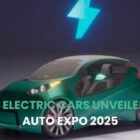The Trickle Charge method is known to use domestic household electricity to charge the EV. There might be problems related to electrical loads and electrical bills. Hence, this particular charging solution is better used with extreme caution. Also, it will be wise to discuss with the electricity provider prior to its use. To ensure peace of mind and optimum reliability, you are recommended to install In-Cable Control Box (ICCB). Otherwise, opt for an AC household charge using Wallbox to charge your EV!
1. Public Charging Stations
In today’s ever-growing network, these stations are located conveniently and spread across urban centers. Thus, if you own an EV, then you don’t have to search high and low to charge it. You may simply download an app on your smartphone and find the nearest charging station to top up your car’s battery quickly. You can even smartly travel longer distances without much trouble. Generally, public charging offers DC Fast Charging or AC Charging using wallbox.
Which option should you choose?
Both DC Fast Charging and AC Charging using wallbox offer quick charging facilities when compared to charging at your home. Based on your EV’ AC charger handling capacity and charging station output, ACP Public Charging is found to be around 3-10 times much faster when compared to AC Household Charging. According to industry experts, all DC-based charging stations can be termed to be superfast in charging Electric Vehicles.
DC Fast Chargers
- It is considered to be presently the fastest way for charging your EV car.
- Its charging capacity in 40 minutes time is from 20% to 80%!
- Charging power offered through 450V+ is above 50kkiW and current to about 125A.
- DC Charge use is to be kept to the bare minimum. Doing so helps prolong the life of the high-voltage battery.
- It uses Combo DC – CCS (Combined Charging System)
DC Vs. AC Charging – What you need to know
In India, Alternating Current (AC) is what the national grid supplies. However, for battery charge purposes, electric cars require using DC charging.
- DC fast charger is found to bypass the onboard charging device. Thus, the EV battery gets a direct power supply. DC Charger is found to be external to the vehicle. Hence it is neither constrained in cost nor size. This effectively means that it offers faster charging.
- AC Charger, on the other hand, supplies the onboard charger of the EV. AC power is then converted to DC, thereby ensuring proper battery charge. However, onboard charging device size is said to be limited by space. For this reason, the power that the battery can derive from AC Charger is quite low. It also means charging is very slow.
Which connector to choose for what kind of charging type?
Do you need to invest in an adapter that can work on different charging types and methods perfectly? The truth is that currently, no universal connector exists for all chargers and all EVs. However, there are different types of connectors that correspond with varying charging levels, thus allowing EV owners and drivers to enjoy fast charging of their EV cars in less time.
- DC Charging Connectors: SAE and CHAdeMO are considered to be the commonly used conductors. However, they both are not interchangeable. You cannot charge an SAE Combo plug using a CHAdeMO port or vice versa. You may be planning to drive your electric car to the nearest EV charging stations in Delhi. But before that get to know your vehicle’s compatibility level with that of the available connectors.
- AC Charging Connectors: For AC Household Charging, the commonly availed AC sockets are Type 1 and 2 connectors. Generally, when you purchase an EV vehicle, be it a scooter or car, the company will provide you with a charge. But with AC chargers, charging time will be very high. You can reduce this time by visiting a charging station close to your home or office.
How do EV chargers prove to be useful to make cities resilient and equitable?
Although India is a developing country, the government is found to be fully committed to reducing pollution considerably. It has passed out several norms, rules, and regulations for industries to use and manufacture equipment and items that produce less pollution in whatever form. EV vehicles are indeed a boon to the global environment and so are charging stations. To promote Electric Vehicles of all sizes and shapes, the government has been offering subsidies to customers.
The need to reduce the impact of climate change
It is found that in decades of using fossil fuels, the level of pollution has increased considerably. This, in turn, has led to global warming which is only getting serious with each passing day. Changing weather patterns combined with increasing natural disasters the world over including in developed countries is sufficient proof that pollution needs to be minimized to the greatest possible extent to ensure the sustainability of the human race.
Worsening air pollution in cities
A good number of cities in the country have been experiencing increasing pollution of which Delhi, the national capital tops the list. The condition is only found to become more severe during winter. The city environment has rather become dangerous and is impacted disproportionately by climate change. Ineffective air quality controls and underinvestment in infrastructure are found to make the situation worse. The installation of electriva charging stations across the different cities of the country is found to be a savior.
Overcoming pollution and public transit issues
In a densely populated city like Delhi or other cities of the country, it is not just possible to phase away vehicles using fossil fuel. Without proper access to viable and cheap public transportation options, it is quite natural for communities to get barred from health, employment, and education opportunities. This puzzle can be solved by promoting electric vehicles and EV charging stations in Delhi.
Promoting Electric Vehicles and Charging Stations
EV vehicles are undoubtedly a wonderful option to curb increasing pollution and to complement public transportation network expansion. To ensure this, it becomes essential to ensure equitable distribution of chargers. Electrification is found to protect health and clean local air. EVs also enable owners to save on maintenance and fuel costs. Thus, as an EV owner, you as the owner as well as the entire community can gain huge. At the same time, you will be doing your bit to control pollution.
Affordable EVs
The fact is EVs using the latest technology and high-end battery for smooth operation have always been expensive. Even a decade ago, not many found it to be beneficial. However, evolving battery technology, better mileage, and more savings, combined with government subsidies have helped EVs to become a popular choice. With each passing day, you can find a good number of EVs on the road.
Installation of Charging Stations
An increasing number of EVs in almost all cities of the country has prompted reputed companies to set up charging stations at accessible points. These stations are found to offer quick and affordable charges to EVs of all sizes, unlike private charging options. The government has also been supporting setting up such charging stations at different points to enable EV owners to get their vehicles charged without having to travel a long distance.
Smart technology
The standalone charging stations is found to be both smart and ubiquitous. Distributed public charging helps tackle expensive charging costs, local air pollution, and transit deserts! New smart technologies are found to allow networks to serve communities in a better way.
Cheaper charging options
Software used in the charging stations combined with longer parking sessions can help derive affordable electricity. Software in managed charging integrations controls charging speed and load. Prioritizing off-peak hours can ensure reduced power demands. Managing charging projects is found to reduce power demand by 45%. This helps diminish costs significantly and ensures reliability. Managing charging also helps clean air and incentivizes renewable generation.
Community safety net
The newly developed technology allows parked EVs to save the community if there is experienced a blackout. EV batteries enabled with V2G (Vehicle-to-Grid) technologies have the power to send back power to the grid via bidirectional charging. Some places face the risk of climate disasters. In such conditions distributed V2G charger network can enable local vehicles to act as backup generators. Thus the community can be offered a safety net during any crisis.
Other benefits of V2G technology
V2G similar to managed charging offers vehicle owners financial incentives. You can earn passive income by providing energy to the grid during peak costly hours. You may resort to using power during low cost times. A bidirectional charger project can help save a good amount of money every month when charging your fleet of vehicles. Thus, you can get paid for parking your EVs, thereby alleviating the cost burdens involved with owning EVs.
Smart charging stations
These days, there is being launched smart EV charging stations across the country. EV charger in Delhi has been set up with the objective to help fast charge EVs thus saving owners precious money and time. These stations can help improve air quality considerably. EVs are no more a sci-fi dream, but an equitable and resilient technology that exists in reality. Thus, cities that are currently facing pollution caused by fuel-based vehicles can convert to greener ones by promoting EVs.



